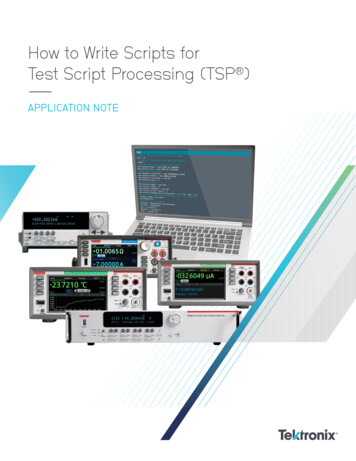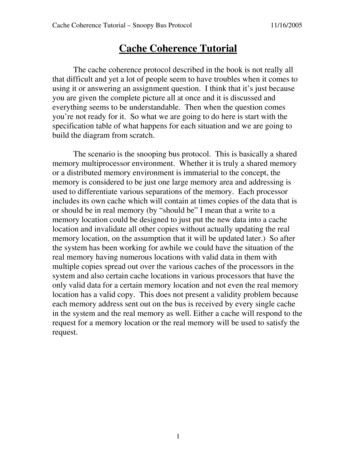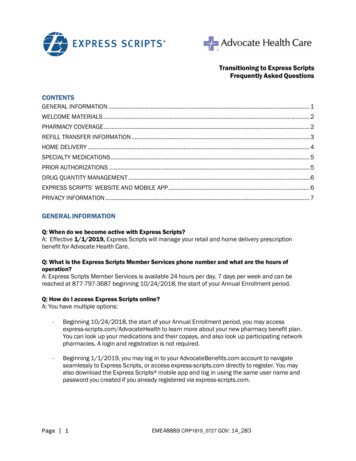
Transcription
How to Write Scripts forTest Script Processing (TSP )––APPLICATION NOTE
How to Write Scripts for Test Script Processing (TSP )IntroductionThis application note introduces scripting with Keithley's TestScript Processor (TSP) technology and its most powerful andenticing features. With scripting, programs and code can beloaded directly onto an instrument and run locally.Keithley’s TSP goes well beyond just sending instrumentcommands. The TSP language is a fully featuredprogramming language with all the capabilities youwould expect including variables and variable typing,math operators, tables, creation of user functions, logicaloperators, string manipulation, conditional branching,loop control, and built-in standard libraries. All these toolstogether, built into the TSP language, allow TSP-enabledinstruments to be their own controller and execute completetest sequences, running local scripts and performing localdata analysis without the communication overhead inherentin other remote instrument control methods.What is TSP?Keithley’s TSP is a flexible hardware/software architecturethat allows message-based programming, much like SCPI,with enhanced capabilities for controlling test sequencing/flow, decision-making, and instrument autonomy. TSPenabled instruments operate like conventional SCPIinstruments by responding to a sequence of commandssent by the controller. You can send individual commandsto the TSP-enabled instrument the same way you wouldwhen using SCPI with any other instrument. Making theswitch to TSP will afford you improved throughput, access toadditional interfacing options between instruments, and theconvenience of autonomous instrumentation.The use of an on-board Test Script Processor has made itpossible to create “smart” instruments, with built-in decisionmaking capabilities, which reduces the need to communicateso frequently with an external controller over the bus. Thisapproach to test system design allows smart instrumentsystems to be much more efficient than those that relyon standard programming. As the number of TSP-basedinstruments grows, test system developers will have greaterflexibility to build test systems with far higher throughputwithout compromising measurement integrity.2 WWW.TEK.COMAPPLICATION NOTETSP encompasses both the TSP command set and the TSPscripting language. The TSP scripting language is basedon Lua version 5.0, and when used together with the TSPcommand set, allows for logic and subroutines that wouldnormally reside on a PC to run inside the instrument, whichreduces the amount of data and number of messages sentover the communications bus by a considerable amount.What is Lua?Lua is a powerful and robust yet lightweight scriptinglanguage that is easy to learn. Lua’s small footprint andreadability made this scripting language the best choice toimplement into measurement instruments. The Test ScriptProcessor scripting engine is a Lua interpreter. Keithleyinstruments use a modified Lua version 5.0. In TSPenabled instruments, the Lua programming language hasbeen extended with Keithley-specific instrument controlcommands. Lua commands can be sent and executed oneat a time like with SCPI. Unlike instruments that are onlycompatible with SCPI, TSP instruments can store full scripts,functions, or variables in their memory, meaning that aninstrument can function completely autonomously onceloaded with a script. For writing these scripts, Keithley TestScript Builder is the obvious choice.Keithley Test Script BuilderKeithley Test Script Builder (TSB) is a free integrateddevelopment environment (IDE) available for TSP. UsingTSB allows you to maximize the benefits of scripting withTSP. The included instrument console can open a directconnection to the instrument from the controlling PC. Unlikeother programming environments, TSB does not require youto directly reference communications libraries or wrappersin their code. You can integrate TSP commands in with therest of your code seamlessly, without having to use a functionto send the command to the instrument because Test ScriptBuilder automatically runs IVI VISA in the background.Test Script Builder has a built-in control structure, andallows you to debug your code, including the usage of TSPcommands. The included instrument console allows youto read error messages and “watch” returned data with theappropriate commands. It should be noted that the TSP
How to Write Scripts for Test Script Processing (TSP )APPLICATION NOTEcommand set does not require any specific developmentcomputer side of the connection and requires the mostenvironment since scripts are compiled and run once theyinteractions across the bus. As a result, assuming all otherare sent to the instrument. However, while IDEs built aroundfactors are equal, this method is the slowest.compiled languages are not necessary for TSP, they can beused all the same. TSP commands can also be used withinother scripting languages such as Python or Perl, althoughTest Script Builder along with Lua based scripting will yieldComputer Forfunc()InstrumentIndividual Commands 100 timesthe best results.Raw DataTo download Keithley Test Script Builder, lderWhy Use Scripting?This next diagram depicts using a computer to send functionScripting is an integral function of TSP that allows users tosuch that the controller is still performing the loop operation,have direct, automatic control of their instrument withoutbut the instrument is processing the function. Perhaps thethe need for an external computer in a similar way that youpreviously mentioned Python script has been cut down towould script a microcontroller such as an Arduino. Scriptsonly perform the loop, while the instrument now handlescan accomplish complex tasks ranging from changing aconfiguring itself and taking its own readings before returningsourced value based on the last reading to synchronizingthem to the computer. The number of interactions betweentrigger sweeps across multiple instruments, or simple tasksthe computer and the instrument are significantly reduced,like displaying text on the instrument display or applying abut can still be shaved down further.calls over the bus. This method splits the programming logicmathematical formula to readings in a buffer. With scripting,the logic control is moved from an external computer to theinstrument itself, cutting down on communication overheadComputer ForInstrumentFunction Calland giving the instrument the power to make decisionsfunc() 10 timeson the fly.Formatted DataThe instrument performs more quickly and efficiently when itprocesses scripts than it does when it processes individualcommands. Scripts eliminate repeated data transfer timesfrom the controller, reducing interface bandwidth. Performingmore data processing on the instrument can reducebandwidth across networks and increase test throughput.For example, where you would normally need to take 100readings, send them to the PC, and then apply a filter beforeobtaining a single result, with a TSP script you can offload thenecessary processing and calculations onto the instrumentso that only a single result is returned to the PC.Consider the following diagram. It depicts the amount ofinteractions across the communication bus when sendingindividual commands from a controlling PC to an instrument.Perhaps the computer is running a Python script to changesettings on the instrument and take readings in a for loop.The final diagram shows a TSP script call being sent to theinstrument by the computer, while all of the logic and dataprocessing is done by the instrument. The computer mightstill be running a python program to call the script, but nowthe computer only receives the final result, allowing theinstrument to perform all the needed math and loops. Thismethod requires only a single interaction across the bus andis by far the quickest method for running tests.ComputerInstrumentScript Call Forfunc() 1 timesResultThis method places all the programming logic on theWWW.TEK.COM 3
How to Write Scripts for Test Script Processing (TSP )APPLICATION NOTEIn the instrument, the Test Script Processor engine processes and runs scripts. Scripting with TSP offers repeatability, a testrunning on the instrument gives best repeatability in timing because the test environment is totally in the instrument. A singlescript can apply the same test to dozens of instruments via instrument-to-instrument communication techniques. Scripts caneven be stored in the instrument’s non-volatile memory or on a USB drive to be accessed from the front panel.Advanced Features of TSPAn Example: Python to TSPIf you currently have a partial or fully developed solution for you application in a language other than TSP, you may be wonderinghow you’ll incorporate TSP into your workflow, or even how to convert your existing code into TSP scripts. The followingexample will walk through the process step by step as described by the previous diagrams.This Python code controls a 2450 SourceMeter Source Measure Unit (SMU) using the open source PyVISA library. The SMU isconfigured to source current and measure voltage in order to determine the forward voltage of a diode. The Python code theninstructs the SMU to source several different current levels and measure the forward voltage at each of those levels. Finally, thedifference between the maximum and minimum forward voltages is printed to the python console.Pythonimport visarm visa.ResourceManager()address "TCPIP0::192.0.0.1::inst0::INSTR" #Keithley 2450 SMUinst rm.open smu.source.func smu.FUNC DC CURRENT")inst.write("smu.source.vlimit.level 21")inst.write("smu.source.autorange smu.ON")inst.write("smu.source.autodelay smu.ON")inst.write("smu.measure.func smu.FUNC DC VOLTAGE")inst.write("smu.measure.autorange smu.ON")inst.write("smu.measure.nplc 1")currlist [1E-7, 1E-6, 1E-5, 1E-4, 1E-3, 1E-2] # list of currents to sourcevoltlist [None for curr in currlist] # Create an empty array for voltage measurements thesame size as our source listfor i, current in enumerate(currlist): # Loop over the current source listinst.write("smu.source.level " str(current))inst.write("smu.source.output ("smu.source.output smu.OFF")voltlist[i] ndindex])") #Grab the last readingvoltlist[i] float(voltlist[i]) # .query returns a string, so it must be castedto a numbervoltDiff max(voltlist) - min(voltlist)print(voltDiff)Now, all the configuration commands are moved into two TSP functions called config() and forwardv(). These functions runthe same commands as the previous python code ran, but they are now stored directly on the instrument so the number ofinteractions the Python code has with the instrument has been greatly reduced. You can find the full contents of each functionin the appendix of this application note.Where before the Python code had 7 interactions during configuration and 5 each loop iteration, the code now has 1 interactionfor configuration and 1 each loop iteration. However, we have changed the communication timeout from Python since eachTSP function will not return a response immediately as before. Instead each function will run multiple TSP commands beforereturning a response that the function has completed.4 WWW.TEK.COM
How to Write Scripts for Test Script Processing (TSP )APPLICATION NOTEPythoninst.timeout 10000inst.write("config()")currlist [1E-7, 1E-6, 1E-5, 1E-4, 1E-3, 1E-2]voltlist [None for curr in currlist]for i, current in enumerate(currlist):voltlist[i] inst.query("forwardv(" str(current) ")")voltlist[i] float(voltlist[i])voltDiff max(voltlist) - min(voltlist)print(voltDiff)This final Python code accomplishes the same task as before, but now with only a single interaction with the instrument. Allthe logic of looping and creating arrays has been moved to TSP so that the Python code now only calls a script and prints theresult. Once again, you can find the full script in the appendix of this application note. At this point, if desired, the computercould be removed from the equation entirely and the result could instead be printed to the front panel of the instrument, ratherthan returned to the computer’s console.PythonvoltDiff inst.query("FullDiodeTest()")print(voltDiff)Script RulesStore & Run Scripts LocallyImportant points regarding scripts:To enjoy the full benefits of scripting, the TSP script must be Each script must have a unique name that cannot startwith a number. Script names must not contain spaces.saved to the instrument’s internal memory. This allows themto be accessed by any remote control scheme or even to berun without a controlling PC from the instrument’s front panel.There are several ways to accomplish this and they all reach If you load a new script with the same name as anexisting script, an error event message is generated. Youmust delete the existing script before you create a newscript with the same name.the same goal. If you revise a script and save it to the instrument with anew name, the previously loaded script remains in theinstrument with the original name.for larger scripts or applications with many functions as You can save scripts to nonvolatile memory in theinstrument. Saving a script to nonvolatile memory allowsthe instrument to be turned off without losing the script.If using Test Script Builder, scripts can be sent and savedto an instrument directly. This method is particularly helpfulTSB provides tools to manage a large number of scriptsacross many different instruments, along with its debuggingcapabilities.Another method, more suited to single or few instrumentsetups, involves simply saving the script with the *.tspextension and placing it on a USB drive. The front panelcontrols of TSP enabled instruments will allow you to runthe script directly from the USB drive, or save the script toinstrument’s internal memory.Finally, when you need to automate the delivery of scripts,or when it is more practical to send scripts over an existingremote connection, scripts may be sent and saved to aninstrument line-by-line. Using the loadscript and endscriptkeywords, any remote communication interface can save TSPscripts to an instrument.WWW.TEK.COM 5
How to Write Scripts for Test Script Processing (TSP )Automatic Execution ScriptsScripts saved to USB drives or the instrument’s internalmemory can be copied to start up. Scripts added to start upwill automatically execute as part of the instrument’s poweron sequence. Below is an example script that changes thebuffer size and sets a DMM6500 6½-Digit Bench/SystemDigital Multimeter to measure current:TSPreset()-- Change the size of the default bufferdefbuffer1.capacity 1000-- Set the measurement function to currentdmm.measure.func dmm.FUNC DC CURRENT-- Take a readingdmm.measure.read()APPLICATION NOTElocal memory. Then, go to MENU SCRIPTS RUN andthen select the script you want saved to the power upsequence and select Copy to Power Up. Alternatively, youcan name your script autoexec.tsp and the instrument willalways run the script at startup.Using Display WindowsTSP scripts give access to user interactions on the instrumentdisplay itself. Display commands will allow you to writescripts that publish custom messages, button prompts, anddata input screens on the front panel of the instrument. Thefollowing example for Keithley’s Touch, Test, Invent line ofinstruments features a short script that creates a menu withtwo options on the front panel. After a selection is made, anTo save the script to the DMM6500’s power up sequenceinput screen appears and takes a numeric input from thefrom the front panel, load the script onto the instrument’suser. Then, the input is printed to the USER swipe screen onthe front panel:TSP-- Creates a GUI with two buttons labeled Set Voltage and Set Currentfunc choice display.input.option("Select a Function", "Set Voltage", "Set Current")-- If user selects Set Voltageif func choice display.BUTTON OPTION1 then-- Prompt user to specify voltage with numeric input box-- Default value is 0, min is 0, max is 15voltage display.input.number("Set Voltage (V)", display.NFORMAT DECIMAL, 0, 0, 15)-- Change swipe screen to USERdisplay.changescreen(display.SCREEN USER SWIPE)-- Print specified voltage to USER swipe screendisplay.settext(display.TEXT1, voltage . " (V)")end-- If user selects Set Currentif func choice display.BUTTON OPTION2 then-- Ask user to specify current limit with numeric input box-- Default value is 0, min is 0, max is 3current display.input.number("Set Current Limit (A)", display.NFORMAT DECIMAL, 0, 0, 3)-- Change swipe screen to USERdisplay.changescreen(display.SCREEN USER SWIPE)-- Print specified voltage to USER swipe screendisplay.settext(display.TEXT1, current . " (A)")end6 WWW.TEK.COM
How to Write Scripts for Test Script Processing (TSP )APPLICATION NOTEAliasingIf you do not like the naming conventions of traditional TSP commands or wish to abbreviate them, you can rename thecommands via aliasing. To alias a command, you can store up to the third “.” , the lowest level, into a variable. With every “.”aliased, the better the script’s performance and the faster the commands are processed. This example demonstrates how tocreate aliases for TSP commands:TSPdm dmm.measurecurrent dmm.FUNC DC CURRENTdm.func current -- Alias for dmm.measure.func dmm.FUNC DC CURRENTstop trigger.model.abortstop() -- Alias for trigger.model.abort()clear eventlog.clearclear() -- Alias for eventlog.clear()Note in the above example, when aliasing a function command like trigger.model.abort, the parenthesis normallyaccompanied with the function is not used. However, when calling the aliased function, stop, the parenthesis is used normally.This behavior is the same for any command that is a function.Reading and Writing to the Front Panel USBYou can write data to files and read data from files saved on a USB drive plugged into the instrument’s front panel using scripts.TSP commands that create and manipulate files are useful for a multitude of purposes, ranging from storing buffer data to aUSB, to accessing initialization files for more complex scripting applications. The code snippet below uses TSP commands andscripting logic to read data from an initialization file if one exists, or create an initialization file with inputs from the user via thefront panel if one is absent:TSP-- Check for USB plugged into front panelusb exist file.usbdriveexists()-- If USB exist is trueif usb exist 1 then-- Check for target filefile check fs.is file("/usb1/Config.ini")if file check true then-- Open and read config file, store config data in variableconfig file file.open("/usb1/Config.ini", file.MODE READ)config data file.read(config file, file.READ ALL)file.close(config file)elseif config data nil or file check false then-- Allow user to input config data and write data to a config fileconfig data display.input.string("Input Config Data", display.SFORMAT ANY)config file file.open("/usb1/Config.ini", file.MODE WRITE)file.write(config file, config data)file.close(config file)endendWWW.TEK.COM 7
How to Write Scripts for Test Script Processing (TSP )APPLICATION NOTESweepingSweeps allow you to set a source measure unit (SMU) to source specific voltage or current values to a device under test, wherea measurement is made for each sourced value. The 2400 Series of SMUs can generate linear staircase, logarithmic staircase,linear dual staircase, and logarithmic dual staircase sweeps from the front panel or from a remote interface. When generating asweep, the instrument creates a source configuration list and a trigger model that contains the settings that were selected forthe sweep. In addition to these generated sweeps, custom list sweeps can be defined using remote commands.When defining a custom sweep, specified source levels are added to a source configuration list. The benefit of a custom sweepis that you can programatically define all the levels of the source configuration list, giving you direct control of sweep ratherthan allowing a sweep function to define the levels for you. The following example for the 2460 SMU defines and executes acustom voltage sweep, calculates several values, and prints the results to the terminal of Test Script Builder and the front panelof the 2460.TSP-- Reset the Model 2460 and clear the buffer.reset()-- Set the source and measure functions.smu.source.func smu.FUNC DC VOLTAGEsmu.measure.func smu.FUNC DC CURRENT-- Configure the measurement settings.smu.measure.terminals smu.TERMINALS FRONTsmu.measure.sense smu.SENSE 4WIREsmu.measure.autorange smu.ONsmu.measure.nplc 1-- Configure the source settings.smu.source.highc smu.OFFsmu.source.range 10smu.source.readback smu.ONsmu.source.highc smu.OFFsmu.source.ilimit.level 5-- Create a configuration list of current source )-- Add source levels to configuration listfor v 1, 9 dosmu.source.level vsmu.source.configlist.store("VoltListSweep")end-- Add Configuration List to Sweepsmu.source.sweeplist("VoltListSweep")-- Start the sweep and wait for it to complete.trigger.model.initiate()waitcomplete()-- Define values for next step.voltage defbuffer1.sourcevaluescurrent defbuffer1imax current[1]vmax voltage[1]pmax voltage[1]*current[1]-- Calculate Max Power, Current, and Voltagefor i 1, 9 do8 WWW.TEK.COM
How to Write Scripts for Test Script Processing (TSP )APPLICATION [i])if (voltage[i]*current[i] pmax) thenpmax voltage[i]*current[i]imax current[i]vmax voltage[i]endendpmax math.abs(pmax)imax math.abs(imax)print("Pmax pmax, Imax imax, Vmax vmax)-- Display values on the Model 2460 front panel.display.changescreen(display.SCREEN USER SWIPE)display.settext(display.TEXT1, string.format("Pmax %.4fW", pmax))display.settext(display.TEXT2, string.format("Imax %.4fA, Vmax %.2fV", Imax, Vmax))TSP-NetWith Keithley TSP-Net, an included library of TSP, you can use TSP-enabled instruments to control any ethernet controllableinstrument. Using this feature, measurement instruments can be controlled remotely by other instruments without a PC. Thistype of setup is especially convenient when an older instrument lacks a front panel or requires navigating through settings withnumerous buttons or knobs. Using TSP-Net, you can use an instrument with a touchscreen to act as a front panel for anotherinstrument that is lacking one. To set up a TSP-Net connection, connect the desired instruments to the same network or to oneanother via ethernet cable and upload a TSP-Net script onto the controlling instrument.TSP-Net works similarly to sockets-based programming between a computer and an instrument. Instead of using a PC, oneof the instruments connected to the network acts as the controller, driving the target instruments through a TSP script via anethernet network connection. This allows one or more instruments that are not necessarily located in the same immediate areato control the others remotely and communicate with each other. The controlling instrument uses commands from the TSP-Netlibrary to transfer string data, including commands, to a remote instrument. In the same way, the controlling instrument canretrieve and manipulate data from the target instruments. Because strings are sent over the bus, a TSP instrument can sendSCPI commands, which are strings of ascii characters, to an instrument that is not TSP compatible with a script using TSP-Net.This example demonstrates the main coding structures and commands associated with the use of TSP-Net. Note the similaritiesbetween these commands from the TSP-Net library and typical sockets based programming:TSP-- Initialize constant value(s) and global variable(s)local remote port 5025-- Default ethernet portlocal remote ip "169.254.136.120"-- Remote instrument IP addresslocal KE3390 idString "Keithley Instruments Inc.,3390" -- 3390 ID Stringlocal tspnet instID nil-- Instrument connection object-- Initialize connection between DAQ and controlled instrumentfunction tspnet init(remote ip, remote port)tspnet.timeout 5.0tspnet.reset()tspnet instID tspnet.connect(remote ip, remote port, "*RST\n")if tspnet instID nil then return nilendtspnet ipaddress remote iptspnet.termination(tspnet instID, tspnet.TERM LF)tspnet send("*RST")return tspnet instIDendWWW.TEK.COM 9
How to Write Scripts for Test Script Processing (TSP )APPLICATION NOTE-- Send command to controlled remote instrumentfunction tspnet send(command)tspnet.execute(tspnet instID, command)end-- Query data from the controlled instrumentfunction tspnet query(command, timeout)timeout timeout or 5.0-- Use default timeout of 5 secs if not specifiedtspnet.execute(tspnet instID, command)timer.cleartime()while tspnet.readavailable(tspnet instID) 0 and timer.gettime() timeout dodelay(0.1)endreturn tspnet.read(tspnet instID)end-- Terminate the connection between the master and subordinate instrumentfunction tspnet destroy()if tspnet instID nil thentspnet.disconnect(tspnet instID)tspnet instID nilendendSee the appendix at the end of this document for the full example script, which uses TSP-Net to send SCPI commands from aDAQ6510 6½-Digit Data Acquisition and Logging Multimeter System to a Keithley 3390 Arbitrary Waveform Generator.ConclusionUsing TSP as a powerful scripting tool can increase the overall functionality of your instruments. TSP affords you a multitudeof advantages, including the ability to run scripts as part of an instrument’s boot sequence and applying custom text andgraphical interfaces to the front panel. Scripting gives users the option to control multiple instruments with a single program,and significantly reduces communications over the bus. Fully integrating logical operations with remote commands creates aplethora of possibilities for new tests.10 WWW.TEK.COM
How to Write Scripts for Test Script Processing (TSP )APPLICATION NOTEAppendixThe following example script uses TSP-Net to send SCPI commands from a DAQ6510 to a Keithley 3390 arbitrary waveformgenerator:TSP-- Initialize constant value(s) and global variable(s)local instPort 5025-- Default ethernet portlocal instAddr "169.254.136.120"-- Remote instrument IP addresslocal KE3390 idString "Keithley Instruments Inc.,3390" -- 3390 ID Stringlocal tspnet instID nil-- Instrument connection object-- Initialize connection between DAQ and controlled instrumentfunction tspnet init(remote ip, remote port)tspnet.timeout 5.0tspnet.reset()tspnet instID tspnet.connect(remote ip, remote port, "*RST\n")if tspnet instID nil then return nilendtspnet ipaddress remote iptspnet.termination(tspnet instID, tspnet.TERM LF)tspnet send("*RST")return tspnet instIDend-- Send command to controlled remote instrumentfunction tspnet send(command)tspnet.execute(tspnet instID, command)end-- Query data from the controlled instrumentfunction tspnet query(command, timeout)timeout timeout or 5.0-- Use default timeout of 5 secs if not specifiedtspnet.execute(tspnet instID, command)timer.cleartime()while tspnet.readavailable(tspnet instID) 0 and timer.gettime() timeout dodelay(0.1)endreturn tspnet.read(tspnet instID)end-- Terminate the connection between the master and subordinate instrumentfunction tspnet destroy()if tspnet instID nil thentspnet.disconnect(tspnet instID)tspnet instID nilendend-- *** Setup Functions for 3390 *********-- Get 3390's instrument IDfunction KE3390 GetIdString()myID tspnet query("*IDN?\n", 5)delay(0.1)return myIDend-- Set Waveform Typefunction KE3390 SetWave()type, result display.input.option("Set Waveform Type", "Sine", "Square", "Ramp")WWW.TEK.COM 11
How to Write Scripts for Test Script Processing (TSP )APPLICATION NOTEif type display.BUTTON OPTION1 thenfreq display.input.number("Set Frequency (Hz)", display.NFORMAT DECIMAL, 1000,.0000001, 50000000)amp display.input.number("Set Amplitude (Vpp)", display.NFORMAT DECIMAL, 0.1)off display.input.number("Set Offset Voltage (V)", display.NFORMAT DECIMAL, 0)tspnet send("APPLy:SINusoid " . tostring(freq) . "," . tostring(amp) . "," .tostring(off) . "\n")delay(0.1)elseif type display.BUTTON OPTION2 thenfreq display.input.number("Set Frequency (Hz)", display.NFORMAT DECIMAL, 1000,.0000001, 25000000)amp display.input.number("Set Amplitude (Vpp)", display.NFORMAT DECIMAL, 0.1)off display.input.number("Set Offset Voltage (V)", display.NFORMAT DECIMAL, 0)tspnet send("APPLy:SQUare " . tostring(freq) . "," . tostring(amp) . "," .tostring(off) . "\n")percent display.input.number("Set Duty Cycle (%)", display.NFORMAT DECIMAL, 0)KE3390 SetDCycle(percent)delay(0.1)elseif type display.BUTTON OPTION3 thenfreq display.input.number("Set Frequency (Hz)", display.NFORMAT DECIMAL, 1000,.0000001, 200000)amp display.input.number("Set Amplitude (Vpp)", display.NFORMAT DECIMAL, 0.1)off display.input.number("Set Offset Voltage (V)", display.NFORMAT DECIMAL, 0)tspnet send("APPLy:RAMP " . tostring(freq) . "," . tostring(amp) . "," .tostring(off) . "\n")percent display.input.number("Set Ramp Symmetry (%)", display.NFORMAT DECIMAL, 0)KE3390 SetRampSymm(percent)delay(0.1)endend-- Set Amplitudefunction KE3390 SetAmp(amp)tspnet send("VOLT " . tostring(amp) . "\n")delay(0.1)end-- Set Frequencyfunction KE3390 SetFreq(freq)tspnet send("FREQ " . tostring(freq) . "\n")delay(0.1)end-- Set Voltage Offsetfunction KE3390 SetVoltOff(off)tspnet send("VOLT:OFFS " . tostring(off) . "\n")delay(0.1)end-- Set Duty Cyclefunction KE3390 SetDCycle(percent)tspnet send("FUNC:SQU:DCYC " . tostring(percent) .
Script Builder is the obvious choice. Keithley Test Script Builder Keithley Test Script Builder (TSB) is a free integrated development environment (IDE) available for TSP. Using TSB allows you to maximize the benefits of scripting with TSP. The included instrument console can open a direct connection to the instrument from the controlling PC .











